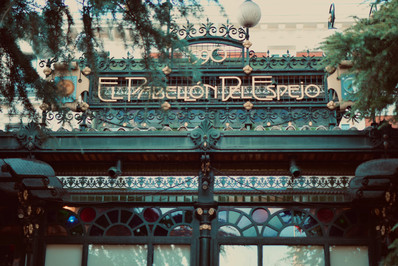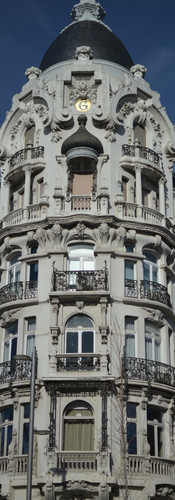The architectural styles in Madrid are the product of different influences.
In its first moments, as the Spanish capital, Madrid assumes the style defined by the Austrians, the Herrerian architecture. With the arrival of the Bourbons and its close relationship with the French and Italian architects changes arose in the architectural currents and the Baroque was established. Progressively, it began a transformation to a neoclassical architecture that will be valid until the XVIII century. At the end of the 19th century and beginning of the 20th century, the Modernist style arrives in Madrid and we tell you what are the 5 buildings that you can not miss if you plan to visit the Capital of Spain.
What is the Modernism Style?
Modernism is an aesthetic ideological proposal that arises as a result of the Industrial Revolution and innovations that completely changed the way of life of the population (such as electricity) being the origin of the development of large cities. As for architecture, trends arise that want to break with traditional criteria, looking for new forms of construction, looking at the arrival of the twentieth century and prioritizing aesthetics.
Architectural Modernism was born in Belgium (art nouveau) with the work Maison Tassel, by Goh Ver Wayans and Victor Horta. It is dominated by the use of the curved line and the inclusion of organic and natural elements.
The birth of this new style also comes from the hand of a magazine founded in London, called The Studio, which dealt with contemporary themes, mixing applied arts and fine arts.
While modernism had a great spread throughout Europe: Art Nouveau in France and Belgium, Modern Style or Glasgow Style in Scotland and the UK, Jugendstil in Germany, Sezession in Austria, Liberty in Italy, etc, At that time, Madrid was not an industrial city and did not have a bourgeoisie that invested capital and was interested in promoting new architectural models. The Madrid bourgeoisie was, rather, aristocratic and used to build ostentatious palaces in the French style.
Despite this we tell you what are the 5 modernist buildings that you can not miss in Madrid and we invite you to learn more about Madrid architecture
Palacio Longoria
The building was built by the financier Javier González Longoria for family residence and offices of its headquarters. It is the work of José Grases Riera, who between 1902 and 1904 built this palace with undulating forms on its facade, a curved tower, sculptures, vegetal reliefs made in stone and other elements that highlight the modernist features, although in the structure and interior distribution adopted more traditional criteria. The building is currently owned by the General Society of Authors and Publishers.
Cine Doré Filmoteca Española
It is currently the screening room of the Spanish Film Library, and is used for the
carrying out all kinds of activities to disseminate the cinematographic heritage
presentation of books, seminars, round tables,
colloquiums, conferences, etc.
It was born as a venue for various social leisure activities known as "a salon". The project was carried out in 1922 by the architect Críspulo Moro Cabeza. Francisco Garriga, specialist in the manufacture of furniture, also intervened. The modernist style that was adopted for the Doré was the usual one in cinematographers of the beginning of the century.
Casa Gallardo
The Gallardo house is an example of art nouveau and the "belle epoque", is the current venue of club allard restaurant that came to add two michelin stars. Located in Plaza España and created by the architect Federico Arias Rey between 1909 and 1915. Its design transmits a great movement and the light tones of its facade contrast with the black of the roof.
It has a large dome that crowns the corner of the building and highlights a golden "G" of Gallardo. It consists of viewpoints and floral elements representative of the modernist style.
The building was a front row spectator of the assault on the Mountain Barracks, which was located where today is the Temple of Debod, just opposite the Gallardo House.
For its uniqueness and beauty it was decided to protect it declaring it as a Good of cultural interest in 1997.
El Espejo Nouveau
El espejo Nouveau stands out for its art-nouveau decoration, reminiscent of the atmosphere of the literary cafés of the early twentieth century. It is a classic and historic meeting point for artists and intellectuals.
It has a Paris 1900 style with the intention of being the Art Noveau bar that Madrid never had. With a magnificent glass pavilion on the Paseo de los recoletos.
Cementerio de Almudena
The cemetery of Nuestra Señora de la Almudena is the main necropolis of the city of Madrid, with 120 hectares of extension, is the largest cemetery in all Western Europe. In 1905 the architect Francisco García Nava took charge of the works, proposing a modernist solution, with secessionist and Gaudian influences, in which symbolist and exotic elements converge. In 1916, under his direction, the number of graves was increased.
The main entrance is Modernist style with Neomudejar influence, using brick, granite for the basement and limestone for the columns. It has in the center three entrance arches, delimited by double columns ending in high pinnacles, and covered by domes. On the central arch is represented the figure of God the Father.
If you are interested in the architectural styles of Madrid do not hesitate to visit our page and consult for our experiences in the city.









































































Comments